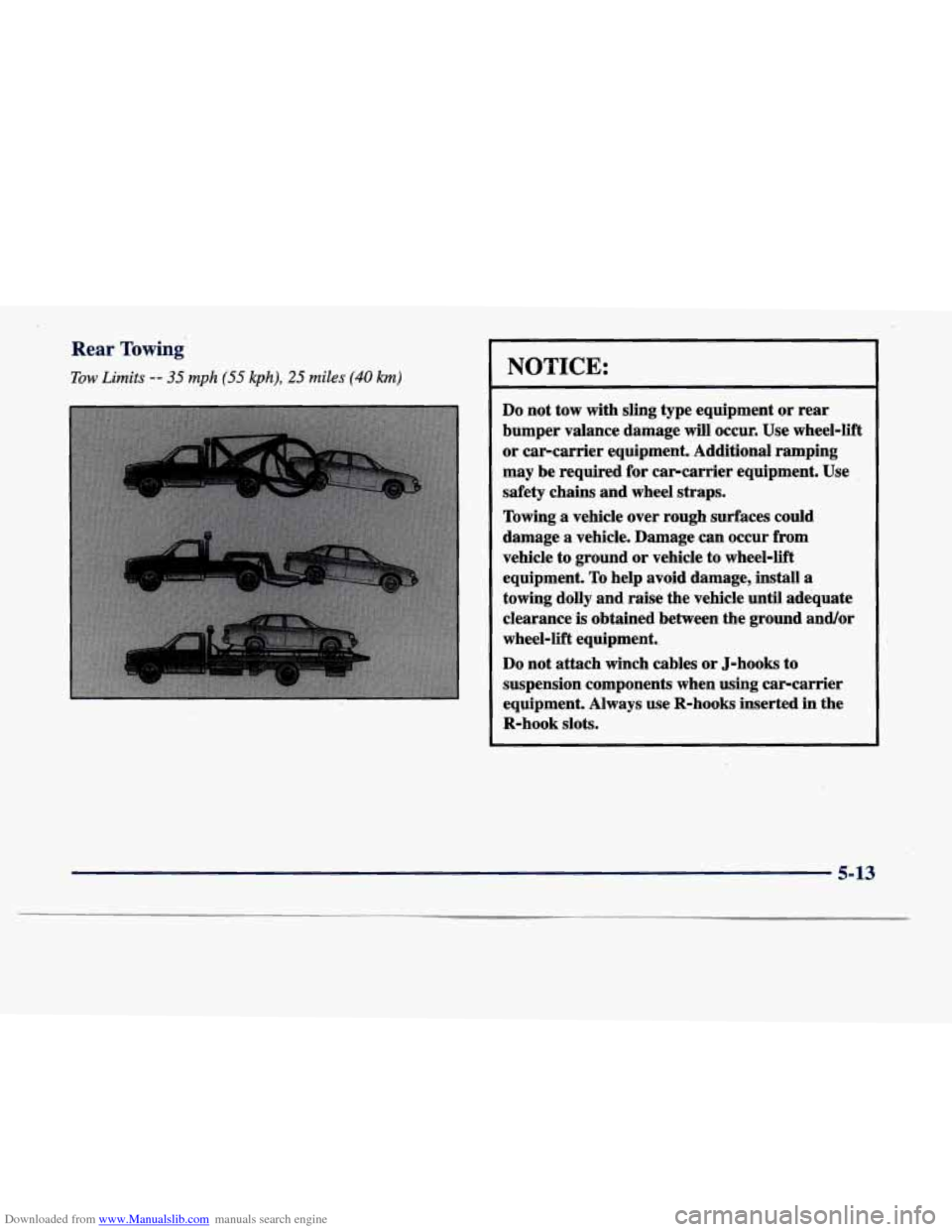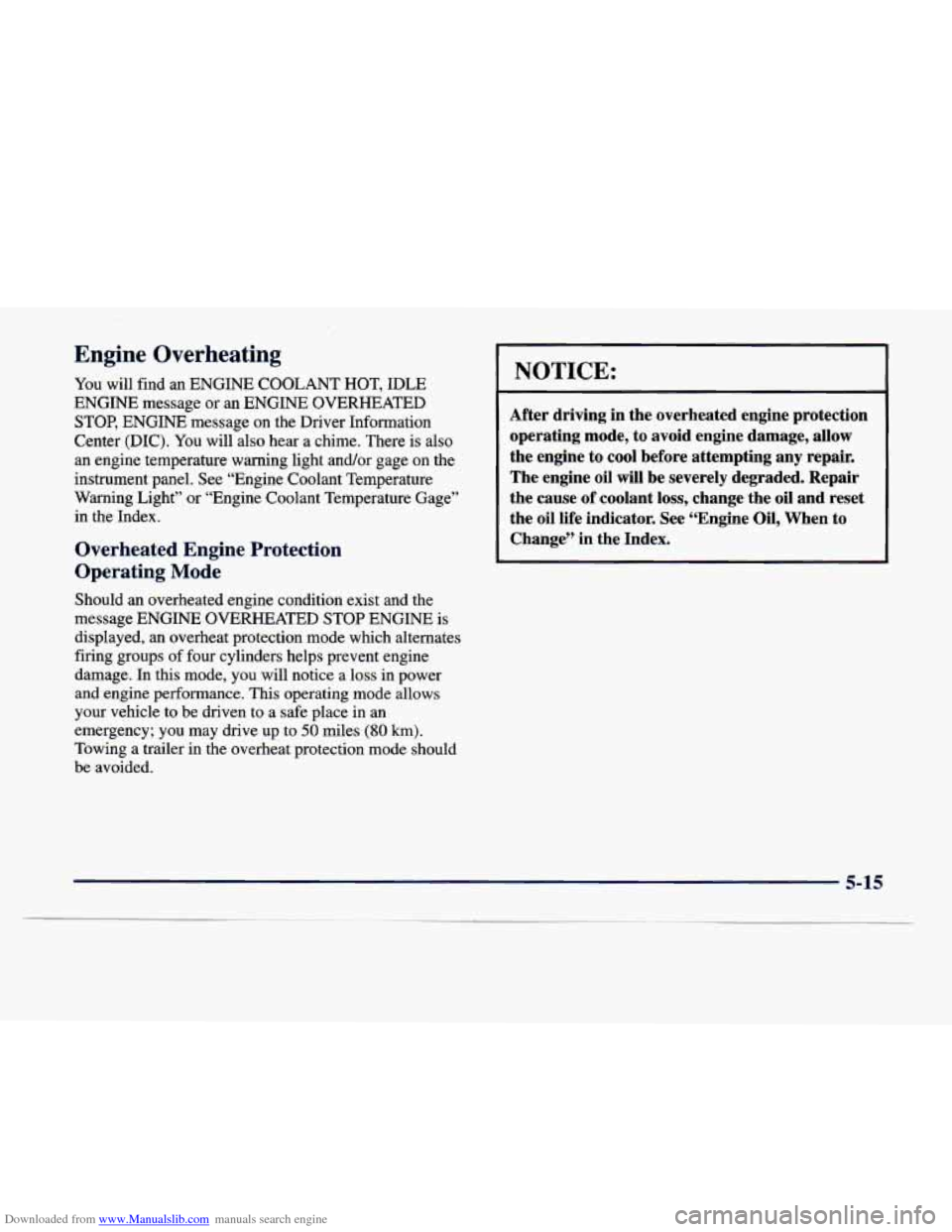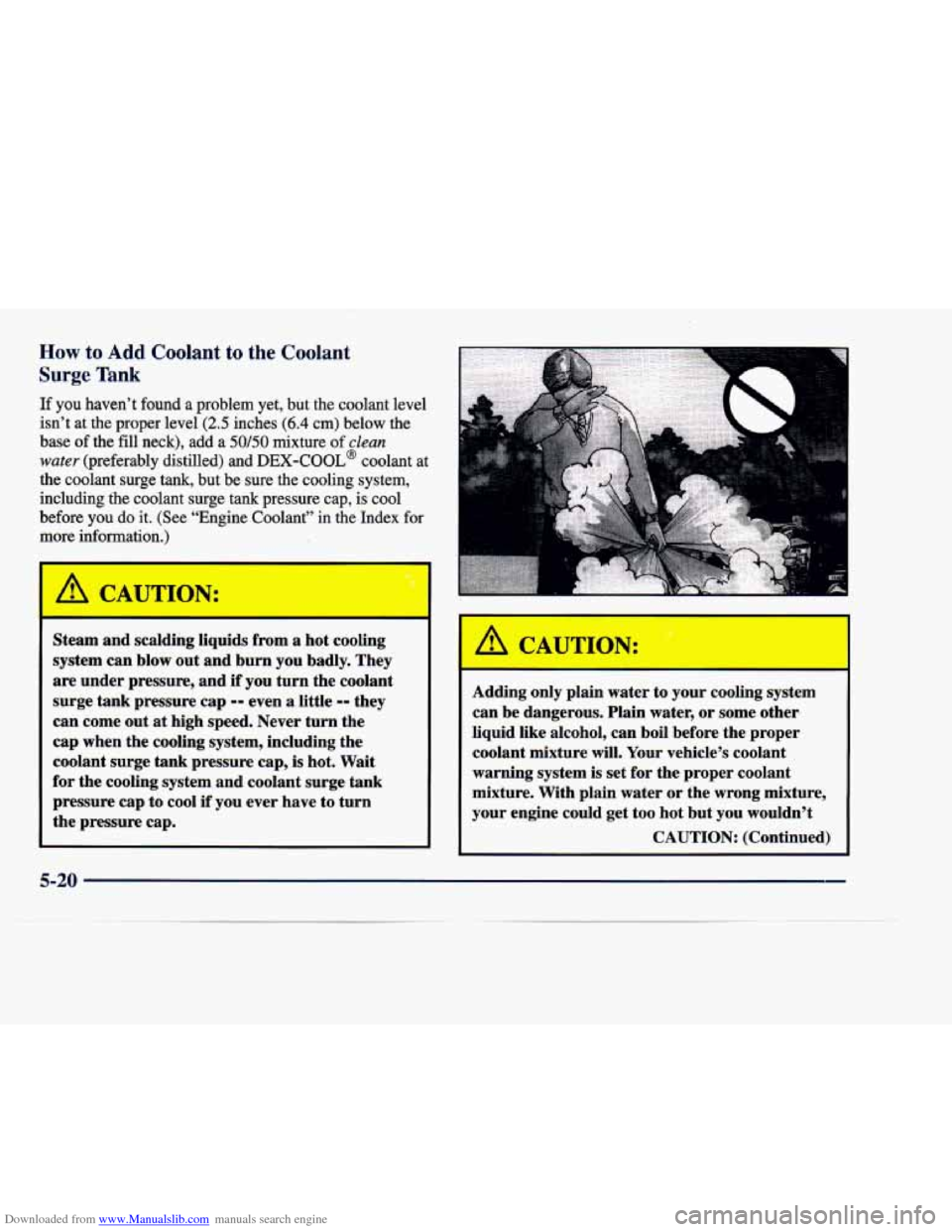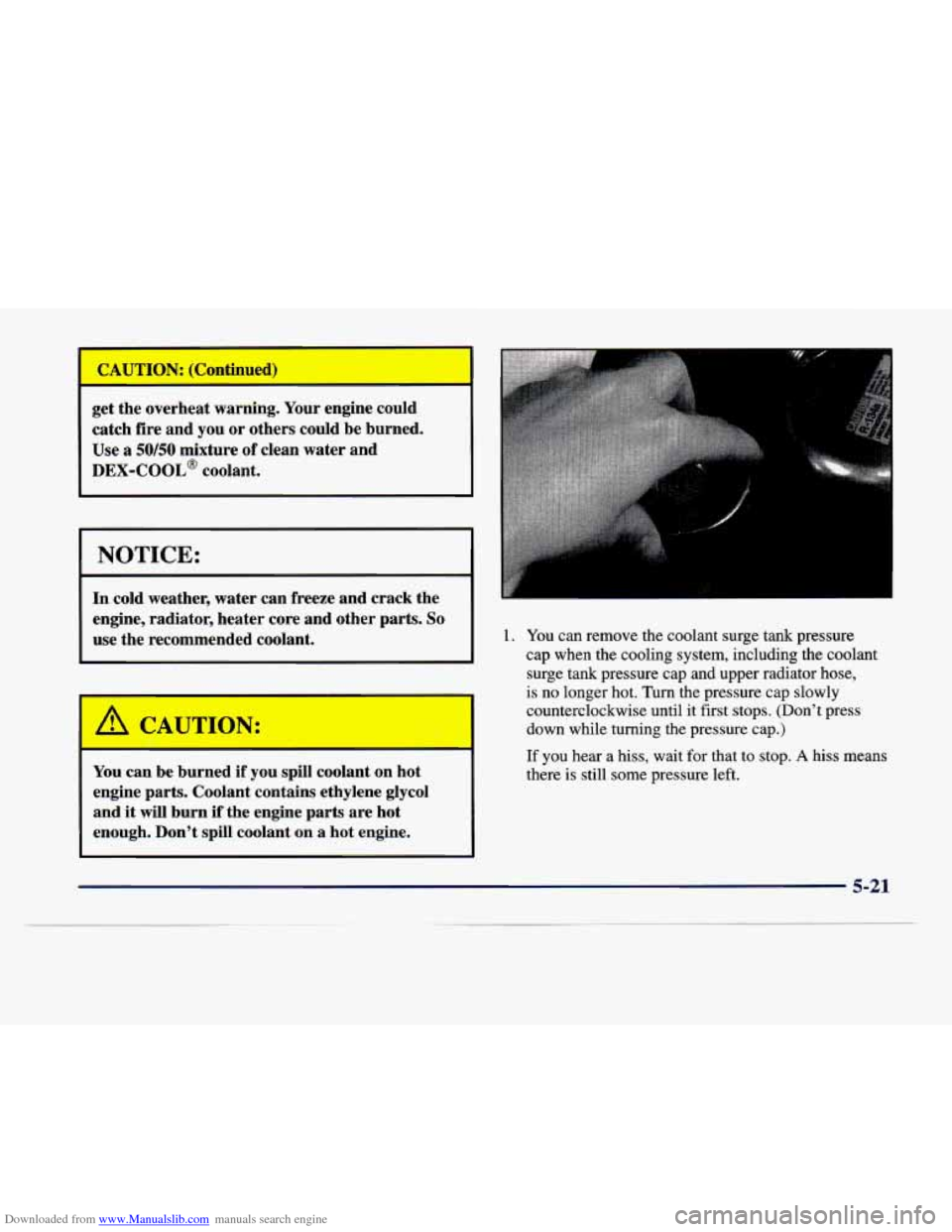CADILLAC DEVILLE 1998 7.G Owners Manual
Manufacturer: CADILLAC, Model Year: 1998, Model line: DEVILLE, Model: CADILLAC DEVILLE 1998 7.GPages: 386, PDF Size: 22.36 MB
Page 261 of 386

Downloaded from www.Manualslib.com manuals search engine Attach T-hook chains on both sides, in the slotted holes
in the bottom of the frame rails, behind the front wheels.
These slots are to be used when loading and securing to
car-carrier equipment. Attach a separate safety chain around the outboard end
of
each lower control
arm.
5-12
Page 262 of 386

Downloaded from www.Manualslib.com manuals search engine Rear Towing
Tow Limits -- 35 mph (55 kph), 25 miles (40 km) NOTICE:
Do not tow with sling type equipment or rear
bumper valance damage will occur. Use wheel-lift or car-carrier equipment. Additional ramping
may be required for car-carrier equipment. Use
.
safety chains and wheel straps.
Towing a vehicle over rough surfaces could
damage
a vehicle. Damage can occur from
vehicle to ground or vehicle to wheel-lift
equipment. To help avoid damage, install a
towing dolly and raise the vehicle until adequate
clearance is obtained between the ground and/or
wheel-lift equipment.,
Do not attach winch cables or J-hooks to
suspension components when using car-carrier
equipment.
Always use R-hooks inserted in the
R-hook slots.
5-13
Page 263 of 386

Downloaded from www.Manualslib.com manuals search engine Attach R-hook chains to the R-hook slots in the frame
rails just ahead
of the rear wheels on both sides. These
slots are to be used when loading and securing to
car-carrier equipment. Attach a separate safety chain around the end of each
axle inboard
of the spring.
5-14
Page 264 of 386

Downloaded from www.Manualslib.com manuals search engine Engine Overheating
You will find an ENGINE COOLANT HOT, IDLE
ENGINE message or an ENGINE
OVERHEATED
STOP, ENGINE message on the Driver Information
Center (DIC). You will
also hear a chime. There is also
an engine temperature warning light andor gage on the
instrument panel. See “Engine Coolant Temperature
Warning Light” or “Engine Coolant Temperature Gage”
in the Index.
Overheated Engine Protection
Operating Mode
NOTICE:
After driving in the overheated engine protection
operating mode, to avoid engine damage, allow
the engine to cool before attempting any repair.
The engine oil will be severely degraded. Repair
the cause of coolant loss, change the oil and reset
the oil life indicator. See “Engine Oil, When to
Change” in the Index.
Should an overheated engine condition exist and the
message ENGINE OVERHEATED STOP ENGINE is
displayed, an overheat protection mode which alternates
firing groups
of four cylinders helps prevent engine
damage.
In this mode, you will notice a loss in power
and engine performance. This operating mode allows
your vehicle to be driven to a safe place in
an
emergency; you may drive up to 50 miles (80 lun).
Towing a trailer in the overheat protection mode should
be avoided.
5-15
Page 265 of 386

Downloaded from www.Manualslib.com manuals search engine If Steam Is Coming From Your Engine I
CAUTION:
Steam from an overheated engine can burn you
badly, even if you just open the hood. Stay away
from the engine if you see or hear steam coming
from it. Just turn
it off and get everyone away
from the vehicle until
it cools down. Wait until
there
is no sign of steam or coolant before you
open the hood.
If you keep driving when your engine is
overheated, the liquids in it can catch fire. You or
others could be badly burned. Stop your engine if
it overheats, and get out of the vehicle until the
engine is
cool.
5-16
Page 266 of 386

Downloaded from www.Manualslib.com manuals search engine I NOTICE:
If your engine catches fire because you keep driving with no coolant, your vehicle can be
badly damaged. The costly repairs would not be
covered by your warranty. See “Overheated
Engine Protection Operating Mode” in the Index.
____~
If No Steam Is Coming From Your Engine
If you get the overheat warning but see or hear no
steam, the problem may not be too serious. Sometimes
the engine can get a little too hot when you:
Climb a long hill on a hot day.
Stop after high-speed driving.
0 Idle for long periods in traffic.
0 Tow a trailer.
If you get the overheat warning with no sign of steam,
try this for a minute or
so:
1. Turn off your air conditioner.
2. Dial temperature control to the highest heat setting
and open the windows, as necessary.
3. If you’re in a traffic jam, shift to NEUTRAL (N);
otherwise, shift to the highest gear while
driving
-- OVERDRIVE (GO) or THIRD (3).
If you no longer have the overheat warning, you
can drive. Just to be safe, drive slower for about
10 minutes. If the warning doesn’t come back on, you
can drive normally.
If the warning continues, pull over, stop, and park your
vehicle right away.
If there’s still no sign of steam, you can idle the engine
for two or three minutes while you’re parked, to see
if the warning stops. But then, if you still have the
warning,
turn off the engine and get everyone out of
the vehicle until it cools down. Also, see “Overheated
Engine Protection Operating Mode” listed previously in
this section.
You may decide not to lift the hood but
to get service
help right away.
5-17
Page 267 of 386

Downloaded from www.Manualslib.com manuals search engine When you decide it’s safe to lift the hood, here’s what \
you’ll see:
A CAUTION:
An electric engine cooling fan under the hood can
start up even when the engine is not running and
can injure you. Keep hands, clothing and tools
away from any underhood electric fan.
If the coolant inside the coolant surge tank is boiling,
don’t do anything else until it cools down.
A. Coolant Surge Tank with Pressure Cap
B. Electric Engine Fans
5-18
Page 268 of 386

Downloaded from www.Manualslib.com manuals search engine If it isn’t, the coolant level should be indicated by a
CHECK COOLANT
LEVEL message on the Driver
Information Center. If it is, you may have a leak in the
radiator hoses, heater hoses, radiator, water pump or somewhere else in the cooling system.
Heater and radiator hoses, and other engine
parts, can be very hot. Don’t touch them.
If you
do, you can be burned.
Don’t run the engine if there is
a leak. If you run
the engine, it could lose all coolant. That could
cause an engine fire, and you could be burned.
Get any leak fixed before you drive the vehicle.
I NOTICE:
Engine damage if you keep running your engine
without coolant isn’t covered
by your warranty.
See “Overheated Engine Protection Operating
Mode” in the Index.
If there seems to be no leak, with the engine on, check to
see if the electric engine cooling fans are running. If the
engine is overheating, both fans should be running..
If
they aren’t, your vehicle needs service.
.
Page 269 of 386

Downloaded from www.Manualslib.com manuals search engine How to Add Coolant to the Coolant
Surge Tank
If you haven’t found a problem yet, but the coolant level
isn’t at the proper level
(2.5 inches (6.4 cm) below the
base of the fill neck), add a
50/50 mixture of clean
water (preferably distilled) and DEX-COOL’ coolant at
the coolant surge tank, but be sure the cooling system,
including the coolant surge tank pressure cap, is cool
before
you do it. (See “Engine Coolant” in the Index for
more information.)
Steam and scalding liquids from a hot cooling
system can blow out and burn you badly. They
are under pressure, and if you turn the coolant
surge tank pressure cap
-- even a little -- they
can come out
at high speed. Never turn the
cap when the cooling system, including the
coolant surge tank pressure cap,
is hot. Wait
for the cooling system and coolant surge tank
pressure cap to cool
if you ever have to turn
the pressure cap. Adding
only plain water to your cooling system
can be dangerous. Plain water, or some other
liquid like alcohol, can boil before the proper
coolant mixture will. Your vehicle’s coolant
warning system
is set for the proper coolant
mixture. With plain water or the wrong mixture,
your engine could get too hot but you wouldn’t
CAUTION: (Continued)
5-20
Page 270 of 386

Downloaded from www.Manualslib.com manuals search engine ~- ~~ ~
get the overheat warning. Your engine could
catch fire and you or others could be burned.
Use a 50/50 mixture of clean water and
DEX-COOL@ coolant.
I NOTICE:
In cold weather, water can freeze and crack the
engine, radiator, heater core and other parts.
So
use the recommended coolant. 1. You can remove the coolant surge tank pressure
cap when the cooling system, including the coolant
surge tank pressure cap and upper radiator hose,
is no longer hot. Turn the pressure cap slowly
counterclockwise until it first stops. (Don’t press
down while turning the pressure cap.)
If you hear a hiss, wait for that to stop. A hiss means
there is still some pressure left.
You
can be burned if you spill coolant on hot
engine parts. Coolant contains ethylene glycol
and
it will burn if the engine parts are hot
enough. Don’t spill coolant on
a hot engine.
5-21